Wasp Facts
Different Types & Species Of Wasp In UK
Around the world there are hundreds of different types of wasp and even more species if you include similar insects like bees and hornets. Whilst to most people, wasps are nothing more than pest, wasps are some of the best pollinators and play a really important role in the ecosystem.
Fun Fact - Did you know that not all types of wasp in the UK will sting you?
It’s important to understand the difference between the various wasp species because everything from their nesting habits to how aggressive they are differs. Ensuring you fully understand the type of wasp nest you are dealing with will help get rid of the wasps without getting hurt.
Here we look at some of the most commonly found types of wasp in Britain.
German wasps (Vespula germanica)
What They Look Like
- Size - From 10mm to 13mm in length once fully grown
- Colouring - Traditional black and yellow bands
- Whilst they look very similar to the common wasp, German Wasps can be identified by the three black dots on its face and similar markings on the underside of their body.
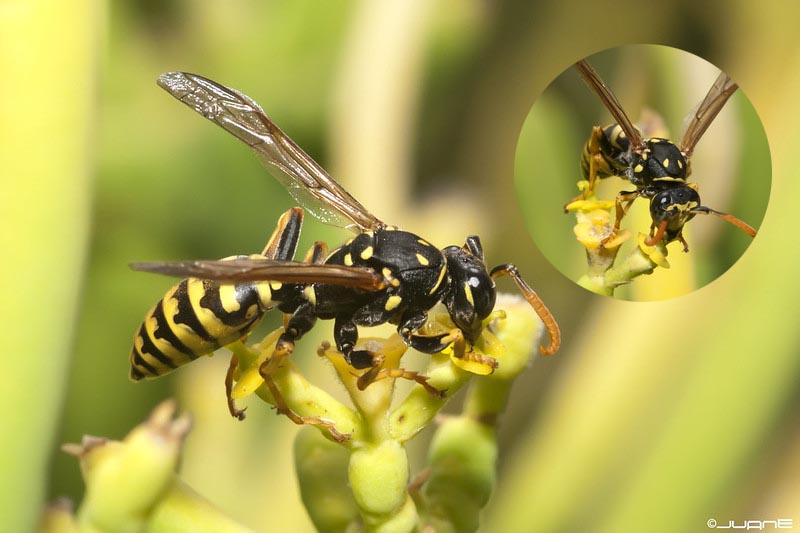
Image Credit: Juan Emilio
Facts about German Wasps
- Sometimes referred to as the ‘European wasp’ or the ‘German yellowjacket wasp’
- A destructive and highly invasive species of wasp that can be very harmful to other wildlife in the same area as the nest.
- Generally speaking these wasps do not travel too far from their original source. In the past humans have assisted with their spread around the world
- The majority of German wasp nests will be found in the ground as this is their preferred habitat. A small percentage of nests will be located in loft spaces or similar locations.
- Unlike other species of wasp where the nest dies over the winter. If a German wasp nest is well protected from the elements then it is possible for the nest to survive the winter and continue to develop and expand the following year. However, if the temperature drops too low and the nest gets cold the nest will die
- German wasps eat a range of different food sources. They will eat the nectar from flowers as well as eating aphids, mosquitoes, larger flies and caterpillars that the scavenger wasps catch and bring back to the nest. Once these wasps identify a lucrative food source, they will continue to return to it until the food runs out
Common wasps (Vespula vulgaris)
What They Look Like
- A normal adult ranges from 12mm to 17mm in length. However the queen can be bigger at around 20mm
- Colouring is a stereotypical wasp. They have the black and yellow bands with a number of rings and dots on their abdomen
- A female common wasp and a common wasp queen looks very similar to the German wasp, however the distinguishing feature is that instead of the three black dots on the face, on a common wasp the black markings on their faces look more like and anchor or dagger shape rather than round dots
- To the naked eye it is almost impossible to distinguish a male common wasp from the German wasp as they are practically identical.
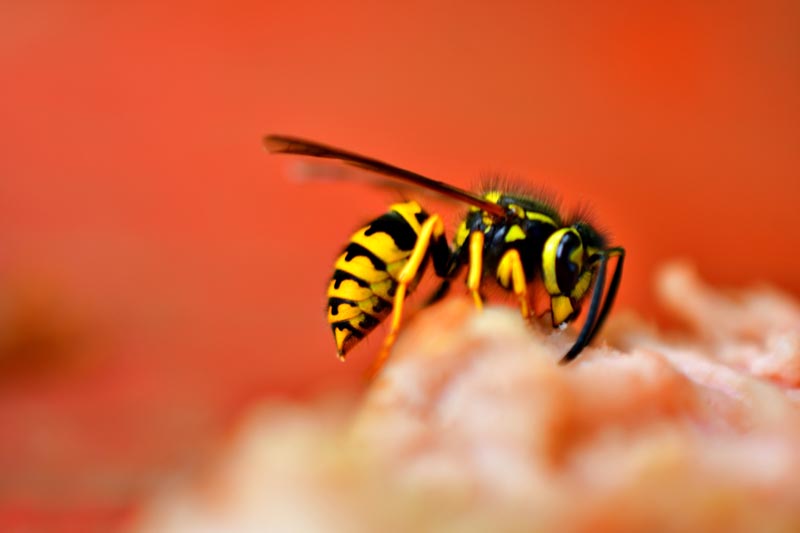
Image Credit: Unsplash
Facts about Common Wasps
- Sometimes referred to as the 'European wasp' or the ' yellowjacket wasp'
- Typically the common wasp likes to find a small nook and cranny to build their nest in. They look for a small dark enclosed space like a cavity wall, hollow tree trunk, holes in buildings and other crevices but they have also been known to nest underground
- Due to the variety in the locations of the nests, the common wasp is very good at adapting to live in a wide range of habitats
- The wasps leave a pheromone trail while out hunting for food to help navigate back to a food source
- A common wasp nest is significantly smaller than a German wasp nest. Due to the lack of food available in the nest, they never survive through the winter and will always die with just the queen wasp surviving
Red wasps (Polistes carolina)
What They Look Like
- Male and female wasps typically reach 25mm to 32mm in length
- Red Wasps are the only UK wasp to have black wings. Their bodies are a red/brown colour
- They sometimes have brown stripes on their abdomen
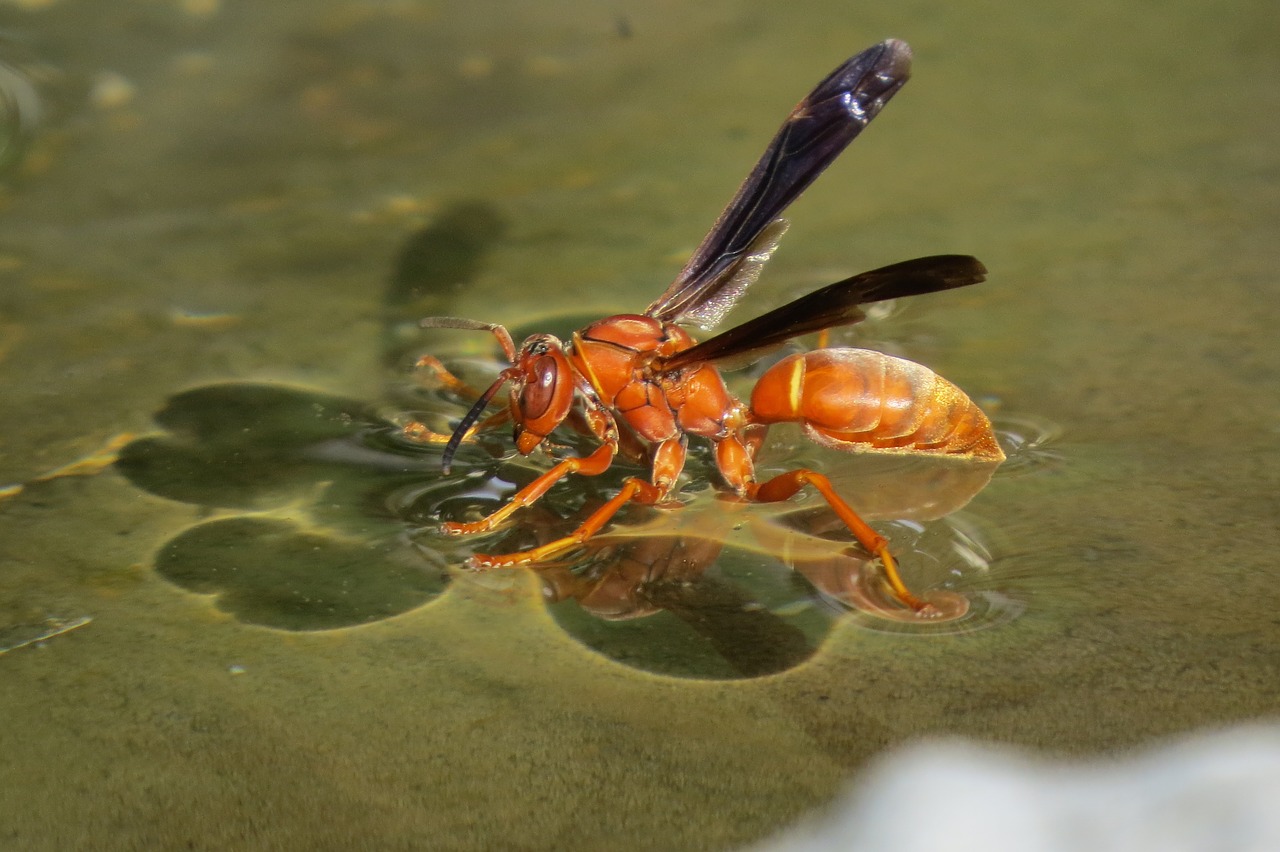
Facts about Red Wasps
- Sometimes referred to as the 'Red Paper Wasp'
- They build some of the largest wasp nests found in the UK. The nests are constructed from a paper-like material (hence the nickname).
- The red wasp likes to build their nest in a well protected and sheltered area and the shape of the nest often look like an upside-down umbrella
- Unlike other species of wasp, the Queen wasp isn't necessarily largest, instead she is just the first to begin building the nest
- As well as enjoying man-made sweet and sugary foods, Red Wasps like to eat caterpillars, nectar, cicadas and some types of larvae
- The Red Wasp is one of the most aggressive species of wasp and because of their size, the sting is far more painful than other types of wasp
Norwegian wasps (Dolichovespula norwegica)
What They Look Like
- Typically these wasps are around 11mm to 18mm in length
- The queen wasp will be significantly bigger than worker wasps
- They have the regular black and yellow coloured bands but there will also be some red areas on the front of the abdomen
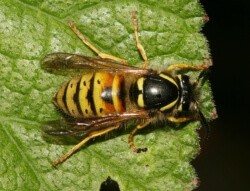
Image Credit: S. Rae
Facts about Norwegian wasps
- They are classed as a tree wasp so the most likely place you will find them nesting is in the lower branches of trees and shrubs
- They eat flies, other small insects like larvae and spiders. Adults wasps will also feed on nectar obtained specifically from snowberry and blueberry flowers
- They don't like urban areas and instead like to build their nests in the walls of houses and gaps in stone walls as well as trees and shrubs but nearly always in rural areas
- Unlike other species of wasp, the Queen wasp isn't necessarily largest, instead she is just the first to begin building the nest
- As well as enjoying man-made sweet and sugary foods, Red Wasps like to eat caterpillars, nectar, cicadas and some types of larvae
- Some nests can stay active until early September but most die off in late August
Tree wasps (Dolichovespula sylvestris)
What They Look Like
- The average length of a Tree wasp is around 11mm to 17mm in length
- The queen wasp will typically be slightly larger at 15mm to 19mm
- They have the regular black and yellow coloured bands with brownish wings; however the distinguishing feature of a Tree Wasp is a black dot in the middle of its face
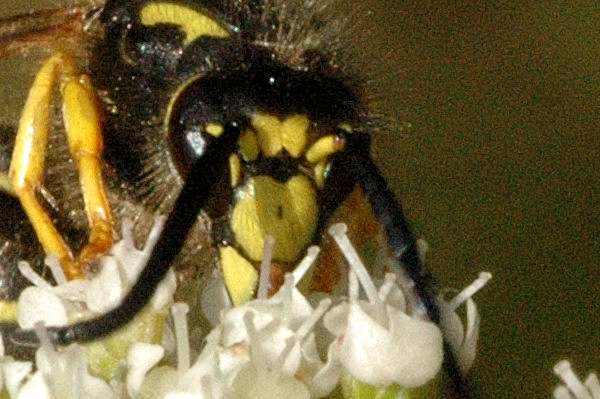
Image Credit: Ecology of Commanster
Facts about Tree Wasps
- Despite the name, a tree wasps nest is not always in a tree. As well as building their nests in aerial locations, they also like to build underground too
- The common thing between all Tree Wasp nests is that they will always be suspended from an overhanging structure. This could be a tree branch, a rock, bush or even thick grass stem
- They don't like urban areas and instead like to build their nests in the walls of houses and gaps in stone walls as well as trees and shrubs but nearly always in rural areas
- This species of wasp are not treated as a pest and you are fairly unlikely to see them because human food does not attract them
- They are one of the least aggressive species of wasp but will still attack you if they feel their nest is being threatened
Saxon wasps (Dolichovespula saxonica)
What They Look Like
- These wasps are slightly larger than other UK wasp species, normally around 11mm to 15mm in length
- Queen wasp will grow bigger than worker wasps to approx 15mm-19mm in size
- They have the stereotypical black and yellow coloured bands like the yellowjacket
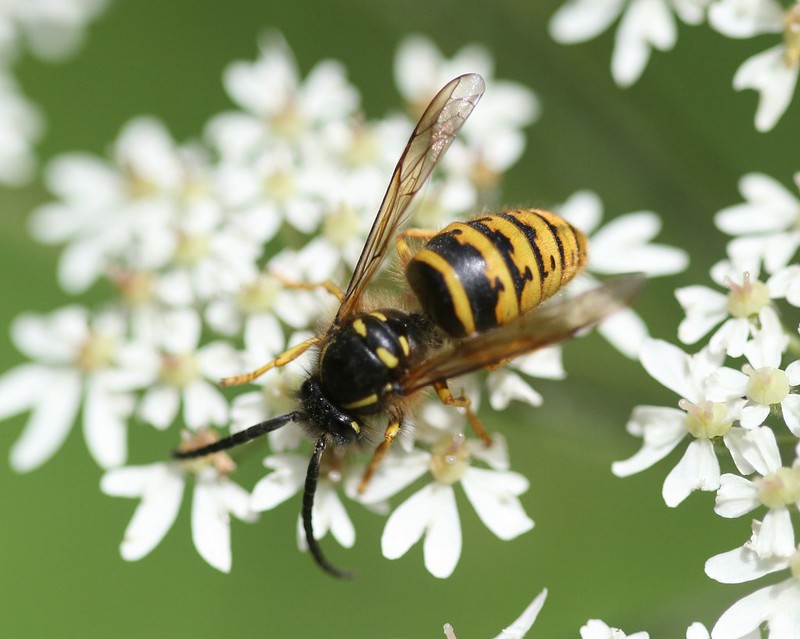
Image Credit: S. Rae
Facts about Saxon wasps
- Their nests are always found above ground in easy to see locations. Often located in buildings, trees and other bushes
- They create small ball-shaped nests made from a paper like material
- Saxon wasps are useful around the garden as they hunt and feed on other insect pests
- As with tree wasps, they are not an aggressive species however they will defend their nest if they feel threatened
- If they come under attack, they emit a pheromone that stimulates aggressive behaviour and attracts other wasps from the nest
- Saxon wasps can spread disease as the nest contains waste that can cause pathogens like Klebsiella oxytoc, Escherichia coli and Candida krusei to develop
Median wasps (Dolichovespula media)
What They Look Like
- Male and female wasps typically reach 16mm to 22mm in length
- The queen wasps have a slightly reddish colour which means they are often mistaken for hornets
- A median wasp is easily identified by its black thorax that has four yellow spots
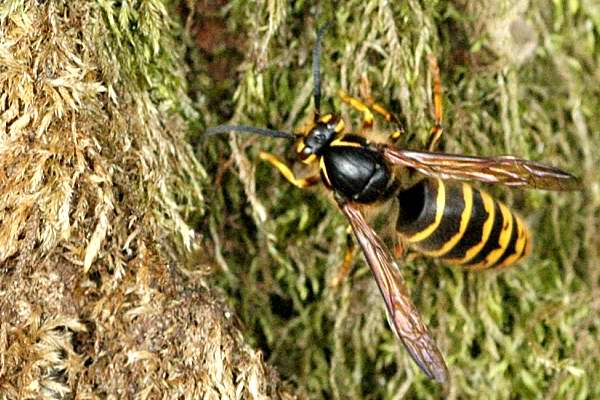
Image Credit: Ecology of Commanster
Facts about Median wasps
- Their nests are built under a structure like a tree, bush or building eaves
- The nest is constructed from a paper material
- They like more humid conditions which is the reason they normally build nests out in the open and close to the ground
- They are not an aggresive species and will normally fly away from you. However like other wasps, if they feel threatened they will sting you
- Unlike other species of wasp, the Queen wasp isn't necessarily largest, instead she is just the first to begin building the nest
- They like the smell of sweet human food so will often buzz around while you are eating or drinking outside






